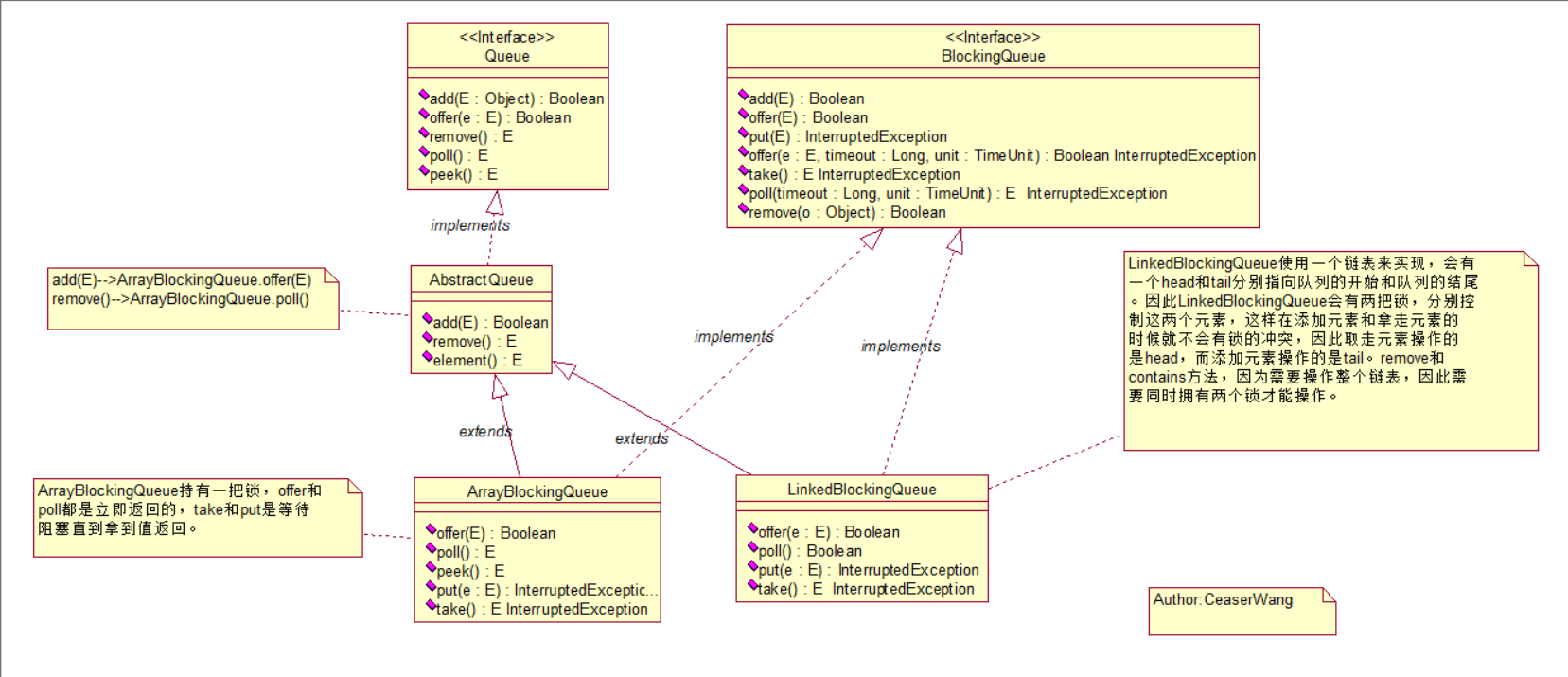ArrayBlockQueue和LinkedQueue属于Java.util.current包下的两个封装的线程安全的队列,主要讨论线程安全和阻塞操作的实现
他们之间的关系如下:

[复制图片地址,在新的浏览器器页面查看大图]
ArrayBlockingQueue:
线程安全和阻塞操作在入队列和取出队列元素都会涉及,先从线程安全进入:
注意:ArrayBlockQueue只有一把锁:
/** Main lock guarding all access */
final ReentrantLock lock;
/** Condition for waiting takes */
private final Condition notEmpty;
/** Condition for waiting puts */
private final Condition notFull;锁的初始化:
public ArrayBlockingQueue(int capacity, boolean fair) {
if (capacity <= 0)
throw new IllegalArgumentException();
this.items = new Object[capacity];
lock = new ReentrantLock(fair);
notEmpty = lock.newCondition();//用于取走队列元素
notFull = lock.newCondition();//用于元素插入队列
}take方法:
/**
* Inserts the specified element at the tail of this queue if it is
* possible to do so immediately without exceeding the queue's capacity,
* returning {@code true} upon success and {@code false} if this queue
* is full. This method is generally preferable to method {@link #add},
* which can fail to insert an element only by throwing an exception.
*
* @throws NullPointerException if the specified element is null
*/
public boolean offer(E e) {
checkNotNull(e);
final ReentrantLock lock = this.lock;
//获取锁,使用可重入锁的同步器,cvs操作,非公平锁
lock.lock();
try {
if (count == items.length)
return false;
else {
insert(e);
return true;
}
} finally {
//释放锁
lock.unlock();
}
}poll方法:
public E poll() {
final ReentrantLock lock = this.lock;
lock.lock();
try {
return (count == 0) ? null : extract();
} finally {
lock.unlock();
}
}再看阻塞:
Condition拥有类似的操作:await/signal。Condition和一个Lock相关,由Lock的newCondition来创建。只有当前线程获取了这把锁,才能调用Condition的await方法来等待通知,否则会抛出异常。
下面来看看put方法就会明白如何使用一个Condition了
put操作
/**
* Inserts the specified element at the tail of this queue, waiting
* for space to become available if the queue is full.
*
* @throws InterruptedException {@inheritDoc}
* @throws NullPointerException {@inheritDoc}
*/
public void put(E e) throws InterruptedException {
checkNotNull(e);
final ReentrantLock lock = this.lock;
lock.lockInterruptibly();
try {
while (count == items.length)
notFull.await();
insert(e);
} finally {
lock.unlock();
}
}take操作:
public E take() throws InterruptedException {
final ReentrantLock lock = this.lock;
lock.lockInterruptibly();
try {
while (count == 0)
notEmpty.await();
return extract();
} finally {
lock.unlock();
}
}实现阻塞的关键就是就是这个notFull的Condition,当队列已满,await方法会阻塞当前线程,并且释放Lock,等待其他线程调用notFull的signal来唤醒这个阻塞的线程。那么这个操作必然会在拿走元素的操作中出现,这样一旦有元素被拿走,阻塞的线程就会被唤醒。
这里有个问题,发出signal的线程肯定拥有这把锁的,因此await方法所在的线程肯定是拿不到这把锁的,await方法不能立刻返回,需要尝试获取锁直到拥有了锁才可以从await方法中返回。
这就是阻塞的实现原理,也是所谓的线程同步。
LinkedBlockingQueue
LinkedBlockingQueue使用一个链表来实现,会有一个head和tail分别指向队列的开始和队列的结尾。因此LinkedBlockingQueue会有两把锁,分别控制这两个元素,这样在添加元素和拿走元素的时候就不会有锁的冲突,因此取走元素操作的是head,而添加元素操作的是tail。
offer方法和poll方法:
/**
* Inserts the specified element at the tail of this queue if it is
* possible to do so immediately without exceeding the queue's capacity,
* returning {@code true} upon success and {@code false} if this queue
* is full.
* When using a capacity-restricted queue, this method is generally
* preferable to method {@link BlockingQueue#add add}, which can fail to
* insert an element only by throwing an exception.
*
* @throws NullPointerException if the specified element is null
*/
public boolean offer(E e) {
if (e == null) throw new NullPointerException();
final AtomicInteger count = this.count;
if (count.get() == capacity)
return false;
int c = -1;
Node<E> node = new Node(e);
final ReentrantLock putLock = this.putLock;
putLock.lock();
try {
if (count.get() < capacity) {
enqueue(node);
c = count.getAndIncrement();
if (c + 1 < capacity)
notFull.signal();
}
} finally {
putLock.unlock();
}
if (c == 0)
signalNotEmpty();
return c >= 0;
}可以看到offer方法在添加元素时候仅仅涉及到putLock,但是还是会需要takeLock,看看signalNotEmpty代码就知道。而poll方法拿走元素的时候涉及到takeLock,也是会需要putLock。参见signalNotFull()。关于signalNotEmpty会在后面讲阻塞的时候讲到。
public E poll() {
final AtomicInteger count = this.count;
if (count.get() == 0)
return null;
E x = null;
int c = -1;
final ReentrantLock takeLock = this.takeLock;
takeLock.lock();
try {
if (count.get() > 0) {
x = dequeue();
c = count.getAndDecrement();
if (c > 1)
notEmpty.signal();
}
} finally {
takeLock.unlock();
}
if (c == capacity)
signalNotFull();
return x;
}这里顺便说说队列长度的count,因为有两把锁存在,所以如果还是像ArrayBlockingQueue一样使用基本类型的count的话会同时用到两把锁,这样就会很复杂,因此直接使用原子数据类型AtomicInteger来操作count。
LinkedQueue的阻塞
一个BlockingQueue会有两个Condition:notFull和notEmpty,LinkedBlockingQueue会有两把锁,因此这两个Condition肯定是由这两个锁分别创建的,takeLock创建notEmpty,putLock创建notFull。
/** Lock held by take, poll, etc */
private final ReentrantLock takeLock = new ReentrantLock();
/** Wait queue for waiting takes */
private final Condition notEmpty = takeLock.newCondition();
/** Lock held by put, offer, etc */
private final ReentrantLock putLock = new ReentrantLock();
/** Wait queue for waiting puts */
private final Condition notFull = putLock.newCondition();put方法:
/**
* Inserts the specified element at the tail of this queue, waiting if
* necessary for space to become available.
*
* @throws InterruptedException {@inheritDoc}
* @throws NullPointerException {@inheritDoc}
*/
public void put(E e) throws InterruptedException {
if (e == null) throw new NullPointerException();
// Note: convention in all put/take/etc is to preset local var
// holding count negative to indicate failure unless set.
int c = -1;
Node<E> node = new Node(e);
final ReentrantLock putLock = this.putLock;
final AtomicInteger count = this.count;
putLock.lockInterruptibly();
try {
/*
* Note that count is used in wait guard even though it is
* not protected by lock. This works because count can
* only decrease at this point (all other puts are shut
* out by lock), and we (or some other waiting put) are
* signalled if it ever changes from capacity. Similarly
* for all other uses of count in other wait guards.
*/
while (count.get() == capacity) {
notFull.await();
}
enqueue(node);
c = count.getAndIncrement();
if (c + 1 < capacity)
notFull.signal();
} finally {
putLock.unlock();
}
if (c == 0)
signalNotEmpty();
}其实大体逻辑和ArrayBlockingQueue差不多,也会需要通知notEmpty条件,因为notEmpty条件属于takeLock,而调用signal方法需要获取Lock,因此put方法也是用到了另外一个锁:takeLock。这里有一点会不同,按照道理来说put方法是不需要通知notFull条件的,是由由拿走元素的操作来通知的,但是notFull条件属于putLock,而拿走元素时,是用了takeLock,因此这里put方法在拥有putLock的情况通知notFull条件,会让其他添加元素的方法避免过长时间的等待。同理对于take方法来说也通知notEmpty条件。
take 方法:
public E take() throws InterruptedException {
E x;
int c = -1;
final AtomicInteger count = this.count;
final ReentrantLock takeLock = this.takeLock;
takeLock.lockInterruptibly();
try {
while (count.get() == 0) {
notEmpty.await();
}
x = dequeue();
c = count.getAndDecrement();
if (c > 1)
notEmpty.signal();
} finally {
takeLock.unlock();
}
if (c == capacity)
signalNotFull();
return x;
}
remove和contains方法,因为需要操作整个链表,因此需要同时拥有两个锁才能操作。






















 4978
4978











 被折叠的 条评论
为什么被折叠?
被折叠的 条评论
为什么被折叠?








